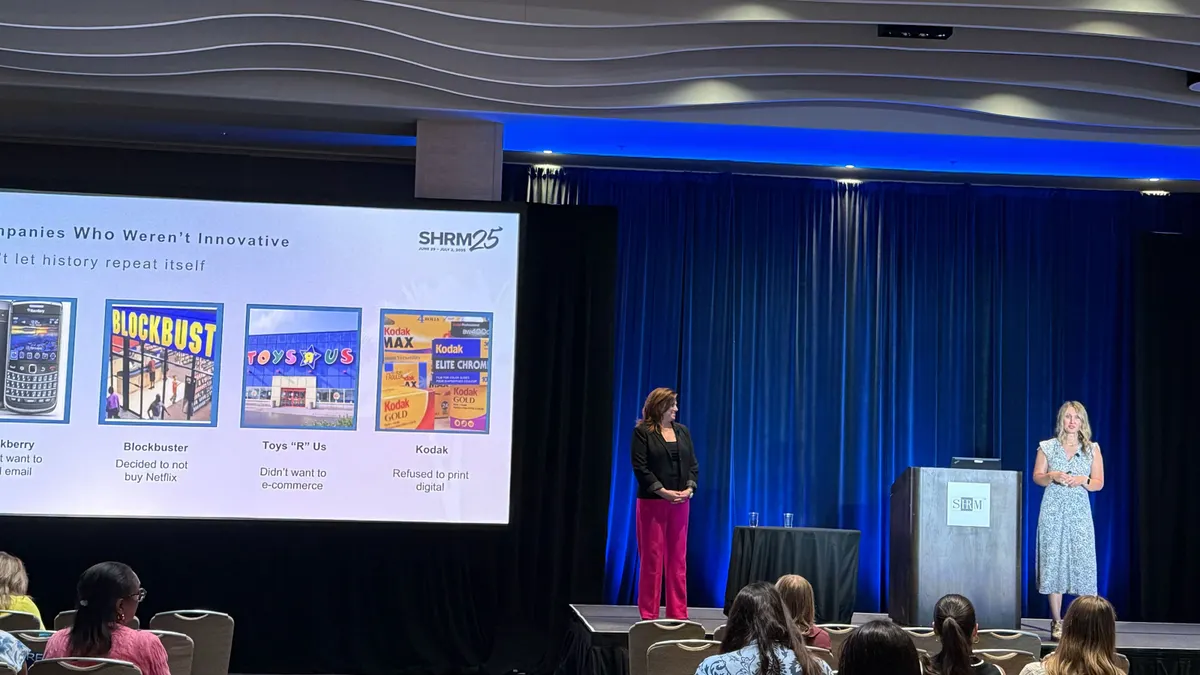Employee engagement is on a downward trend among U.S. organizations going into 2023.
That’s according to a recently published Gallup survey that found 32% of full- and part-time employees said they were engaged by their work, compared to 34% in 2021 and 36% in 2020. 2021 marked the first annual decline in engagement in a decade, Gallup said.
By contrast, Gallup found that 18% of employees were “actively disengaged,” down two percentage points from 2021. Actively disengaged employees contrast employees who are simply not engaged in that the former are “actively likely to leave” and may be “disgruntled with their organizations,” said Jim Harter, chief scientist, workplace wellness and well-being at Gallup.
Harter further demonstrated the difference using the quiet quitting paradigm that has taken HR by storm in the past year. Actively disengaged employees, he said, fit the bill of “loud quitters,” whereas employees who are simply not engaged may be considered “quiet quitters.”
Quiet quitting has become intertwined with discussions about engagement in 2023, but in some ways the term is not a new concept, according to Clare Miller, executive VP and CHRO at Atlantic Union Bank. “It might have a new vernacular, but the actual meaning of what it represents is not something unique. We’ve always had employees who are disengaged to some degree.”
What improves engagement?
At its core, engagement is really a way to describe the discretionary energy that employees put into their day jobs, Miller said. “They might be taking a shower and ideating on a new project or thinking through, ‘How do we make a process better?’ It’s going above and beyond.”
Clarity of expectations represented one of the biggest components of engagement loss last year, according to Gallup. Setting job expectations is “the most foundational part of engaging somebody,” Harter said, given the confusion that can ensue when an employee’s expectations about a job don’t match the reality.
“Confusion leads to disrespect,” Harter said. “People feel like they’re not getting what they signed up for.”
Managers are a consistent talking point in engagement topics, and it’s important for managers to think about how their reports’ jobs are structured and have ongoing conversations about expectations, Harter said. He added that Gallup found that having at least one meaningful conversation with an employee every week can help improve engagement.
Those conversations need not be longer than 15 to 30 minutes and should cover important topics such as goals, customer service, well-being and recognition, according to Gallup. Recognition, in particular, may be a topic for managers to focus on to ensure they are aware of employees’ accomplishments and care about their progress, Harter said.
Atlantic Union Bank leverages data to understand engagement; that includes engagement survey and pulse survey data as well as “qualitative conversations” to identify potential “hotspots” for engagement troubles, Miller said. “If we’ve got a manager issue or a leadership issue that’s contributing to disengagement, we can triage that and rally around it and employ strategies to overcome it.”
A perfect solution is not always possible, though. For employees who are actively disengaged, “unfortunately, best practices would suggest that there’s not a lot you can do,” Miller said. “Over time, we hope to essentially transition those folks out into roles where they can feel better about the work that they’re doing.”
Taking time to listen to employees doesn’t always mean that managers or HR teams can solve every issue on the spot, Harter said, but it does allow employers to ensure they are aware of potential issues and practice recognition. “It’s hard to do that unless you’re listening to [employees] and know what they’ve done,” he continued.
Miller said organizations also need to consider “the whole person” when thinking about engagement issues. “People are not one dimensional,” she said. “They don’t just show up and work 9-to-5 and occupy a job. They are mothers, daughters, sisters, church members and contributors to their communities. They are multi-dimensional.”
Employers, likewise, should take a multi-dimensional approach to engagement, Miller said. Areas such as financial wellness and mental health, supported by employee benefits like caregiver time off, can approach different aspects of engagement at work.
Flexibility debate is key
Gallup noted that the largest decline in employee engagement observed in its survey was among employees in “remote-ready jobs” who were working fully on-site. That finding is significant and demonstrates the importance of honoring the fact that employees may realize the benefits of doing at least part of their jobs independently and avoiding commutes, Harter said.
Employers and employees, however, have noted the benefits of in-person collaboration. To balance the two, Harter said organizations may consider designating on-site days that accurately reflect when a large number of employees will be in an office or other on-site location.
That’s different from an in-office mandate, Harter said, because the employer is instead suggesting to employees that they will see a large number of co-workers in the office on certain days, rather than requiring attendance.
“We found that when you ask people how to decide when you’re going to be in the office, the highest engagement was when people decided together,” Harter said. “The best way to see it is not a mandate, but more as an announcement that this is a new way of working and this is the way we’re going to designate time to collaborate.”
Organizations also can look to their values and culture to form flexibility strategies, Miller said. Atlantic Union Bank has declared some standards and expectations around in-office attendance because, she added, that mode of work “contributes to culture in meaningful ways when we are intentional about designing in-office experiences.” The company defines hybrid work as approximately three days in an office, with Wednesday serving as an “anchor day” in which office density is particularly high.
On-site experiences also may help drive engagement for younger workers, whom Gallup identified as feeling less connected to areas such as customer service and organizational mission. For example, all workers in the survey under age 35 experienced a decline in having someone within their organizations who encouraged their development, as well as having opportunities to learn and grow.
On-site work can help younger workers introduce themselves to potential mentors, managers and other peers, Harter said. This, in turn, can provide opportunities for development and connection with company values.
Above all though, Miller said employers must continue to evolve their engagement strategies to deal with a changing work environment.
“It’s really critical that engagement plays a role in informing how we think, operate and act,” Miller said. “But we’re also very humble in acknowledging that this is ongoing work and work that we need to continue to lean into.”





















